
Home About Us Contact Us Subscribe

Home About Us Contact Us Subscribe
|
|
|
|
INSIGHT: Art in Architecture: Ancient Simpatico By Gordon Huether
An artist partners his art with architecture - to the extent that he even has a patent for a glass art technique that meets stringent requirements of contemporary building codes. by Gordon Huether August 21, 2002 Art and architecture
partnered together have the ability to transcend our experience of place in
both public and private settings by bringing a new level of relevancy,
spiritual as well as material, into our daily lives. Art plays a crucial role
in the architecture of a building by enriching the human experience, while
enhancing the architecture. When art is incorporated into a building, a
structure becomes more accessible to the viewer, both physically and
emotionally. The collaboration between art
and architecture is an ancient and universal tradition. Art served a sacred
function when first used in buildings or dwellings. Today, art continues to
fulfill a spiritual need. In a diverse, fast-moving society that doesn’t have a
single unifying view of the sacred, art in the environment can provide a
channel for the contemplation of life’s mysteries. Within my own work, I
explore the use of transmitted light through such materials as metal and glass.
Whether creating art glass panels, mounted autonomous artwork, freestanding or
suspended sculpture, I try to bring something new into the space while
complementing the surrounding architecture. One of the earliest examples
of art being incorporated into its environment is the Paleolithic cave
paintings discovered at such sites as Altamira and Lascaux. They are thought to
have a ritual significance related to hunting. The caves were sacred places or
sanctuaries where early man exploited the natural architecture of the caves,
painting animals on curved walls and domed ceilings to suggest the movement of
a herd. No attempt was made to alter the rock, but the art actually complements
the pre-existing qualities of the spaces. Another early example where
art played an integral role in the overall architecture of a building was the
ancient Egyptian pyramids and temples. The pyramid complex at Giza is an
architectural, as well as artistic and sacred, monument. Built 4,000 years ago,
the pyramids protect and preserve the bodies of the Pharaohs Khufu, Khefre, and
Menkaure. The hieroglyphic writing artfully applied to the temple walls is a
means of communicating each king’s accomplishments and feats. Art objects also
fill the tombs with those things that a spirit would need for an eternity. Greek, Roman, and Byzantine
architecture included art as an essential part of the building. Two examples in
Greece are the Temple of Apollo and the Parthenon. The Temple of Apollo
contains the statue of Apollo and has a marble frieze sculpted over the
columns. The Parthenon was built to contain the gold and ivory sculpture of
Athena sculpted by Phidias. These early examples of public art displayed a
city’s prosperity and glory while paying homage to the gods. Often architecture emulates
the trends and styles popular in the art world. This simultaneous development
of important ideas and considerations often leads to major movements.
Architects such as Gropius, Mies van der Rohe, Le Corbusier, Aalto, and Wright
built on the design foundation established by art movements such as Art Noveau,
Expressionism, Futurism, and the International movement, to create a major
revolution which resulted in modern architecture. Naum Gabo, a Russian
constructivist, was making transparent tower-shaped sculptures in 1920, while
in Germany Mies was making a model for a glass skyscraper. Conversely, one of
the major art movements of the 20th Century, Post-Modernism, originated not in
the realms of painting or sculpture but in the world of architecture. Many
visual artists use the term “Post-Modern” to refer to a break from the modern
era. With the secularization of
art and its spread into the private home, fewer public spaces were designed to
contain art. The designs of Frank Lloyd Wright’s houses included everything
from lighting fixtures and rugs to wall hangings—he thought that a home which
contained furnishings of the client’s choice disrupted the harmony of the
design. Modernists concentrated on the simplicity and function of a building,
whether it was an office tower or a private home, without using excessive
ornament. Only recently has art been integrated back into the structure of a
building. Successfully integrating art
into architecture presents many challenges for an artist. When contemplating
the type of artistic installation best suited for a building or the space
within, I often form the basis of my concepts by gaining a solid understanding
of the aesthetic established by the architecture. Relating to this aesthetic, I
detect and respond to the visual dialogue created by the buildings’ designers.
By creating site-specific works of art for each project, I am thereby
integrating each piece into the existing architecture. In 1993, in response to the
stringent requirements of contemporary building codes, I developed a new glass
art technique. Now patented, this process allows artistically altered glass to
be fully installed into a commercial glazing system. When creating an
installation for the San Francisco Bay Area Rapid Transit (BART) system’s new
San Bruno transit center, I designed the work to be in perfect harmony with the
proportions and colors of the building. The work is not placed or attached onto
the building, but rather it is integrated into its skin. The installation is
made of two 15-by-15-foot glass murals, one integrated into each elevation of
the terminal, connected by a ribbon of red glass that complements the color of
the building. The art must relate to the
users of the space by appropriately responding to the needs of the occupants.
For example, I recently did a series of installations for the University of
California-San Francisco Comprehensive Cancer Center’s meditation room. I
worked closely with Cynthia Perlis, the hospital’s Art for Recovery Director,
to create the intended feeling for the space. The artwork adds elements of
light and color, while drawing imagery and themes from nature to create a
comforting and meditative atmosphere. Often, by investigating the
unique qualities of each project, I find an inspiring focal point that drives
the rest of the design. For the Museum of Art in Tendo, Japan, my primary
challenge was to pay tribute to the legendary artist Hiroshige, while
responding in my own artistic voice with an original work that would create a
visual dialogue with the building. In a glass mural I emulated the intensely
rich gradation of blue that was a consistent element in many of Hiroshige’s
prints. In the final piece, bold color, abstracted form, and strong composition
simultaneously pay tribute to the art, the artist, and the architecture of the
museum. My philosophy regarding art
is that the work should communicate something relevant to the viewer. Content
that is telling a story, directly or indirectly, is a cornerstone of my work.
Historic images of old town Sacramento, California, are incorporated into a
glass collage for a parking garage in that city. A series of undulating light
sculptures pick up the visual rhythm of train tracks as they speed by at a
transit station for South Eastern Pennsylvania’s Transit Authority. An
installation for the University of Alaska Geophysical Institute utilizes
agates, fossils, trilobites, and other raw natural resources: these are just a
few examples of how I feel it’s necessary to create concepts relative to the
overall project in a literal or symbolic manner. My last guideline for
creating artwork for an existing building is that it must reflect my artistic
soul and spirit, or otherwise run the risk of lacking life. Without this
component, art is reduced to decoration. It is absent of inspiration,
commentary, meaning, reflection, and original expression. Gordon Huether was born in Rochester, NY in 1959 to German
immigrant parents. He moved to the San Francisco bay area in 1963 where he has remained.
Having dual citizenship in Germany and the U.S., Huether has spent much time
traveling between both places. He learned art composition and appreciation at
an early age from his father. In the course of his initial artistic
explorations, Huether resolved to create a lasting impact on the world around
him through the creation of large-scale works of art. In 1987, he founded his
studio in a converted tannery building in Napa, California, with a mission to
create site-specific art installations. It is modeled partly after an
architectural firm and partly as a collaborative art studio. Huether was
awarded his first public art project in 1989 for the University of Alaska’s
Geophysical Institute. Since then, he has completed public and private projects
in the U.S., Mexico, Australia, Hong Kong, Japan, Philippines, Fiji, and Korea.
Commissions include corporate, hospitality, health care, educational,
transportation/airports, and ecclesiastic projects. Huether is constantly
pursuing the realization of his dream to have a lasting and positive influence
through the creation of large-scale projects all over the world. |
(click on pictures to enlarge) 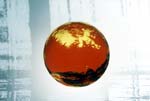 (Misha Bruk) Detail: Charles Schwab Building, San Francisco; Public Art Award 2001. Etched, fused, and enameled glass, each panel 45"x33". Architect: HOK San Francisco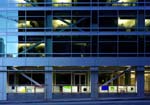 (Misha Bruk) Charles Schwab Building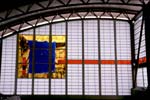 (Israel Valencia) San Bruno BART Station, California; Public Art Award 2001. One of two glass murals, fused, etched, and enameled glass, laminated optical and colored glass, 15'x15'. Architect: Greg Roja & Associates (Israel Valencia) San Bruno BART Station, second mural.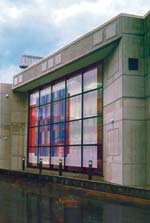 (Gordon Huether) Hiroshige Museum of Art, Tendo, Japan. Private commission, 1995. Mouthblown, etched, and laminated glass. Architect: Kumagai Gumi Ltd.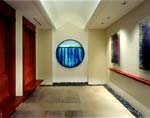 (Misha Bruk) UCSF Comprehensive Cancer Center at Mount Zion, San Francisco, 2001. Etched and enameled glass, steel 60"-diamter medallion. Architect: SmithGroup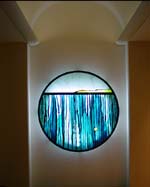 (Misha Bruk) Detail: medallion detail (Misha Bruk) UCSF Comprehensive Cancer Center at Mount Zion, San Francisco, 2001. Dichroic glass, silk-screened enamel on glass triptych; each panel: 22"x48"x3"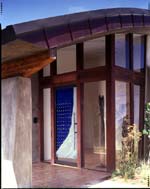 (Ethan Kaplan) Heyman Residence, Carmel, California, 2001. Etched and laminated glass with sculpted bronze door pull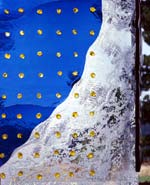 (Ethan Kaplan) Heyman Residence door detail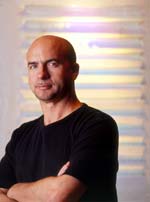 (Dona Bonick) Gordon Huether |
© 2002 ArchNewsNow.com